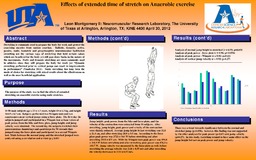
ATTENTION: The works hosted here are being migrated to a new repository that will consolidate resources, improve discoverability, and better show UTA's research impact on the global community. We will update authors as the migration progresses. Please see MavMatrix for more information.
Show simple item record
| dc.contributor.author | Montgomery, Leon II | en_US |
| dc.date.accessioned | 2012-05-31T19:47:50Z | en_US |
| dc.date.available | 2012-05-31T19:47:50Z | en_US |
| dc.date.issued | 2012-05-31 | en_US |
| dc.identifier.uri | http://hdl.handle.net/10106/9768 | en_US |
| dc.description | KINE 4400 | en_US |
| dc.description.abstract | Stretching is commonly used to prepare the body for work and protect the exercising muscles from sudden exertion. Ballistic, dynamic, active, passive, static, isometric and proprioceptive neuromuscular facilitation stretching are the various ways of stretching that hold certain values which are beneficial for the body yet still pose draw backs in the nature of the movements. Static and dynamic stretching are more commonly used in athletics since they still prepare the body for work yet “dynamic stretching performed prior to vertical jumps can result in improvements in performance” (Vanderka 2011). Static stretching has long been the mode of choice for stretching with mixed results about the effectiveness as well as the most beneficial application. | en_US |
| dc.description.sponsorship | Wilson, Judy, Ph.D. | en_US |
| dc.language.iso | en_US | en_US |
| dc.subject | Wingate test | en_US |
| dc.subject | Static stretching | en_US |
| dc.subject | Anaerobic exercise | en_US |
| dc.title | Effects of extended time of stretch on anaerobic exercise | en_US |
| dc.type | Presentation | en_US |
| dc.publisher.department | Department of Kinesiology, The University of Texas at Arlington | en_US |
| dc.publisher.department | Exercise Science Research Laboratories, The University of Texas at Arlington | en_US |
| dc.publisher.department | Neuromusclar Research Laboratory, The University of Texas at Arlington | en_US |
Files in this item
- Name:
- effects of extended time.pdf
- Size:
- 198.2Kb
- Format:
- PDF
- Description:
- PDF
This item appears in the following Collection(s)
Show simple item record


